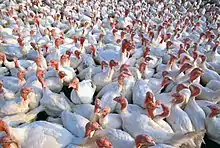
The domestic turkey is a large poultry bird. The modern domesticated form descends from the wild turkey (Meleagris gallopavo), one of the two species of turkey (genus Meleagris); in the past the ocellated turkey (Meleagris ocellata) was also domesticated.
The turkey is raised throughout temperate parts of the world and is a popular form of poultry, partially because industrialized farming has made it very cheap for the amount of meat it produces. The female domesticated turkey is referred to as a hen and the chick as a poult. In the United States, the male is referred to as a tom, while in Europe, the male is a stag. The average lifespan for a domesticated turkey is ten years.
The great majority of domesticated turkeys are bred to have white feathers because their pin feathers are less visible when the carcass is dressed, although brown or bronze-feathered varieties are also raised. The fleshy protuberance atop the beak is the snood and the one attached to the underside of the beak is known as a wattle.
Despite the name, turkeys have no direct relation to the country of Turkey and are native to North America; see further under Turkey (bird): History and naming. (Full article...)